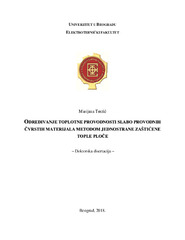Određivanje toplotne provodnosti slabo provodnih čvrstih materijala metodom jednostrane zaštićene tople ploče
Thermal conductivity measurements of poorly conductive solid materials by using the single-sided guarded hot plate method
| dc.contributor.advisor | Petričević, Slobodan | |
| dc.contributor.other | Barjaktarović, Marko | |
| dc.contributor.other | Milošević, Nenad | |
| dc.contributor.other | Gvozdić, Dejan | |
| dc.creator | Terzić, Marijana | |
| dc.date.accessioned | 2019-05-16T10:20:07Z | |
| dc.date.available | 2019-05-16T10:20:07Z | |
| dc.date.available | 2020-07-03T08:33:51Z | |
| dc.date.issued | 2019-02-11 | |
| dc.identifier.uri | http://eteze.bg.ac.rs/application/showtheses?thesesId=6770 | |
| dc.identifier.uri | https://nardus.mpn.gov.rs/handle/123456789/11034 | |
| dc.identifier.uri | https://fedorabg.bg.ac.rs/fedora/get/o:19652/bdef:Content/download | |
| dc.identifier.uri | http://vbs.rs/scripts/cobiss?command=DISPLAY&base=70036&RID=51343631 | |
| dc.description.abstract | Tema disertacije je razvoj, izrada i validacija aparature po metodi jednostrane zaštićene tople ploče koja omogućava određivanje toplotne provodnosti slabo provodnih čvrstih materijala u temperaturnom opsegu od 10 °C do 50 °C sa visokom tačnošću i preciznošću, tj. relativno malom mernom nesigurnošću od oko 2 %. Pored toga, doprinos ovog rada je i realizacija algoritma za spregu numeričkog modela sa eksperimentom, čime se omogućava veća efikasnost i jednostavnost korišćenja merne procedure. Detaljnim pregledom literature izabrana je ova merna metoda koja kod slabo provodnih materijala može obezbediti rezultate sa najmanjom mogućom mernom nesigurnošću. Po njoj je realizovana aparatura kvadratnog poprečnog preseka i dimenzija radne površine 300 300 mm2. Projektovanje aparature i optimizacija dizajna njenih glavnih delova su izvršeni upotrebom softverskih alata zasnovanih na metodi konačnih elemenata (FEM). Razvijen je detaljan 3D FEM model kojim je ispitan uticaj različitih parametara aparature na tačnost merenja na osnovu čega su izvedeni zaključci o osetljivosti aparature na njihovu promenu. Dat je detaljan opis izrade svih delova aparature, kao i prikaz kompletne eksperimentalne postavke. Poseban osvrt je dat na razvoj programskog rešenje za podešavanje, kontrolu, akviziciju i prikaz podataka. Validacija realizovane aparature i predložene merne procedure je izvršena korišćenjem sertifikovanog standardnog referentnog materijala od pireks stakla, model BCR-039C, u temperaturnom opsegu od 10 °C do 50 °C. Dobijeni rezultati toplotne provodnosti su bliski referentnim vrednostima i u okviru opsega referentne merne nesigurnosti što ukazuje na uspešnost izvedene validacije. Prikazani su i rezultati dobijeni ispitivanjem reproduktivnosti aparature, kao i razmatranjem uticaja toplotnog kontaktnog otpora na rezultate merenja. Poređenjem rezultata merenja i numeričkih 3D simulacija izvršena je verifikacija razvijenog 3D modela aparature. Na osnovu toga je osmišljena i testirana sprega 3D simulacije i merenja, tj. posebna iterativna procedura za određivanje krajnje vrednosti toplotne provodnosti uzorka ispitivanog materijala. | sr |
| dc.description.abstract | The subject of this work is development, realization and validation of a new single-sided guarded hot plate apparatus for thermal conductivity measurement of poorly conductive solid materials in the temperature range from 10 °C to 50 °C and with high accuracy and precision, i.e., relatively low measurement uncertainty of about 2 %. Besides, this work contributes in the development of an iterative procedure combining 3D simulation and measurement, which provides both the efficiency and simplification of the measurement procedure. Upon a detailed review of literature the measurement method, which could insure results with a lowest possible measurement uncertainty in the case of poorly conductive materials, was chosen. According to this method, a square cross section apparatus of 300 300 mm2 working surface was developed. Optimal design of the apparatus and its main parts is based on the finite element method (FEM) modelling. A detailed 3D FEM model was developed and used for an analysis of the influence of different parameters on the measurement accuracy. Based on this analysis, the conclusions about the performance of the apparatus are drawn. Detailed description of the development of all parts of the apparatus is given, along with the complete experimental setup. Special insight is given in the development of the software for adjustment, control, display, and data acquisition. Validation of the developed apparatus and proposed measurement procedure was carried out by using standard reference material, Pyrex glass, model BCR-039C. Obtained results for thermal conductivity were very close to the reference values and within the range of reference measurement uncertainty, which indicated the success of performed validation. Results obtained by testing of the apparatus reproducibility are also given, along with the results of testing the influence of contact resistivity on the measurement accuracy. Verification of the developed 3D model was performed by comparison between measurements and results of 3D numerical simulation. Based on the latter, the iterative procedure combining 3D simulation and measurement was developed and tested for the determination of appropriate correction of final thermal conductivity value of the specimen under test. | en |
| dc.format | application/pdf | |
| dc.language | sr | |
| dc.publisher | Универзитет у Београду, Електротехнички факултет | sr |
| dc.relation | info:eu-repo/grantAgreement/MESTD/Basic Research (BR or ON)/174031/RS// | |
| dc.rights | openAccess | en |
| dc.rights.uri | https://creativecommons.org/licenses/by-nc-nd/4.0/ | |
| dc.source | Универзитет у Београду | sr |
| dc.subject | metoda jednostrane zaštićene tople ploče | sr |
| dc.subject | single-sided guarded hot plate method | en |
| dc.subject | thermal conductivity | en |
| dc.subject | poorly conductive materials | en |
| dc.subject | apparatus validation | en |
| dc.subject | 3D model | en |
| dc.subject | toplotna provodnost | sr |
| dc.subject | slabo provodni materijali | sr |
| dc.subject | validacija aparature | sr |
| dc.subject | 3D model | sr |
| dc.title | Određivanje toplotne provodnosti slabo provodnih čvrstih materijala metodom jednostrane zaštićene tople ploče | sr |
| dc.title.alternative | Thermal conductivity measurements of poorly conductive solid materials by using the single-sided guarded hot plate method | en |
| dc.type | doctoralThesis | en |
| dc.rights.license | BY-NC-ND | |
| dc.identifier.fulltext | https://nardus.mpn.gov.rs/bitstream/id/5150/Disertacija.pdf | |
| dc.identifier.fulltext | https://nardus.mpn.gov.rs/bitstream/id/5151/IzvestajKomisije20042.pdf | |
| dc.identifier.fulltext | http://nardus.mpn.gov.rs/bitstream/id/5150/Disertacija.pdf | |
| dc.identifier.fulltext | http://nardus.mpn.gov.rs/bitstream/id/5151/IzvestajKomisije20042.pdf | |
| dc.identifier.rcub | https://hdl.handle.net/21.15107/rcub_nardus_11034 |



